Some may argue that hyper-casual is probably one of the easiest genres to analyse when it comes to game design. Some may argue that hyper-casuals aren’t worth analyzing because it’s a trend that will die soon. I beg to differ, and I wonder who are these people and why do they argue so much?
I don’t claim to be an expert in hyper-casuals. I am just a consumer who can no longer enjoy games as a consumer, thanks to my analytical game designer eyes. Since I’ve been playing (analysing) a lot of hyper-casual games on mobile recently, I thought, why not do a short write up on what’s so intriguing about them and what we as game designers can learn from them. Again, it’s not a go-to guide on making hyper-casuals, it’s a short hypothesis (always wanted to use that word) on various game design choices and systems that help make hyper-casuals fun. If you don’t agree on something, know that I’m always up for debates.
Let’s dive right in, shall we?

Hyper what?
For those living under a rock for the past few years, a hyper-casual game is an ultra-simple game that offers an addictive gameplay loop, combined with minimalist art, and usually playable with nothing but a screen tap. It often presents straightforward goals – get the highest score (Stack), clear levels (Phases), and more. Think of it as something developed in a game jam, but with better production quality and meta.
If you are someone like me who looks forward to the App Store refresh every week, you will notice hyper-casuals taking the App Store by storm, and that’s because of a good reason. Since these games are built around minimalism, developers can produce them quickly within a few weeks, if not months. This is a part of the strategy that makes hyper-casuals a success, and you’d see all major hyper-casual publishers like Ketchapp, Voodoo, Appsolute Games release at least one game a week. And boy, people love ’em – Hyper-Casuals were downloaded more than 100M times in 2018!
But enough about numbers and analytics, let’s get our hands dirty!
Let me play this thing already!
For the sake of simplicity and since I can’t possibly play all the hyper-casual games available on mobile, I am going to use a few of the popular games as examples while exploring different areas in the genre.
With that said, let’s start with discovery.
One day, I was bored and browsing Instagram. That’s how I discovered this game called ‘Ball Blast’. A short 30-sec video ad, showing nothing but the best features of the game, made me download the game. The video showed how easy it was to play the game and beat it. In short, it looked fun. I wanted to start playing it immediately, which was made possible thanks to the low download size, a crucial thing for hyper-casuals.
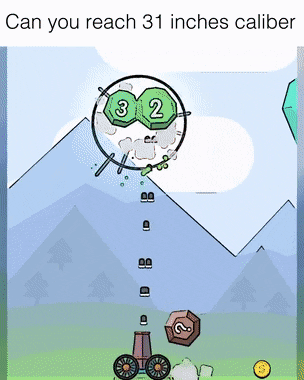
An example of an ad that runs on social media
Now, you have to understand how most of the users discover these games. Hyper-casuals rely majorly on User Acquisition campaigns on social media. Whenever someone’s browsing one of these social media channels, it’s safe to assume that they are bored. They are looking for ways to bring an end to this boredom, and that’s where these hyper-casuals come in as a ‘Knight in Shining Armor’, ready to put an end to their misery.
The idea is to quickly educate potential players about this game that’s super fun and allow them to start playing instantly. Since they’re browsing on their phone, chances are that they are on mobile data. Nobody likes to download GBs of data while on mobile, except if you are super rich or your daddy pays your bill. Even if you are on Wi-Fi with good download speed, it’s hard being patient after seeing how fun the game looks in the ad. Hence, the low download size.
Okay, so the player has managed to download the game and is ready to enter the game’s world. Now what? This brings us to our next topic – onboarding.
Roughly, it takes about 7 seconds for a player to decide if the game’s fun and worth the storage space on his phone. Such a short window means, no lengthy tutorials or UI transitions!
Ball Blast does just that. The moment you fire up the game, you’re presented with the game screen which says “swipe to shoot”, and that’s the only gameplay ‘tutorial’ you ever receive. You touch the screen, and the canon starts shooting bullets.
How inviting!
When you start shooting, you notice that the canon also has the ability to move horizontally by following your finger. When your brain has become used to the idea of shooting and moving, multiple numbered balls enter the game area for you to shoot. You shoot the balls, watch them explode dropping coins, and realize that bigger balls burst into smaller ones. Simple, isn’t it?
Same goes for this neat little game called Stack by Ketchapp which also boots at the game screen, allowing the player to start the game by tapping anywhere. As soon as you tap, you watch a square move to-and-fro, and you learn that whenever you tap, the moving square drops on the stack of squares below and any part which is outside the stack gets trimmed out. Because these games boast a simple single mechanic, it’s reasonably easy to teach it without using complex tutorials. The player learns by failing and overcoming the challenge. The gameplay is “Youtubeable”, meaning, it’s easy to learn by just watching.
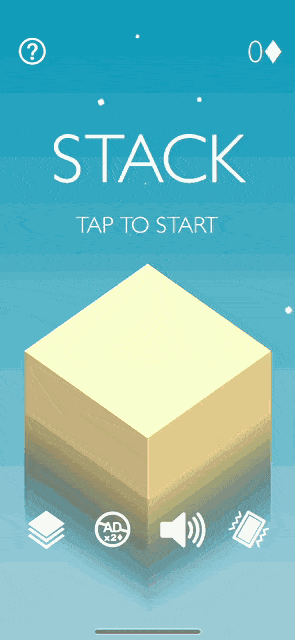
Get in and get out!
Have you noticed how easy and quick it is to start playing a hyper-casual game on your phone? You take the phone out, unlock it, tap on the game’s icon, and within 2 seconds you are in! Isn’t that great?
That’s what the brain wants when it’s dead-bored and wants a potion that can revive it instantly. I start the game, play a session, fail a couple of times, beat my high score, and collect my rewards. That’s what makes up the short feedback loop in the core gameplay. The actions contributing to success or failure are communicated instantly. Combine this with upgrades (discussed later in the blog) and you have a strong positive feedback loop that’s rewarding and highly engaging while being short.
EDIT: In the short feedback loop illustrated below, you’d realise that the player also improves by failing, thanks to Sampath for pointing that out!
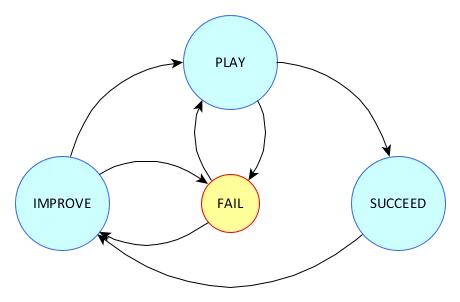
If you’ve managed to create a game with a fun gameplay hook and the players love it, know that’s probably the only thing they care about in your game. Ball Blast puts me right into the action as soon as I start the game because it understands my needs — instant fun. No UI transitions, cutscenes, or texts.
Even if I play the game after a week, I know how to interact with the game, thanks to the ultra-simple mechanic, and no prior commitments. Getting in and out of a game session is another crucial aspect that helps towards the success of these games.
While at work, I often take breaks in the form of short game sessions on my phone and I rely on hyper-casuals for the same, because I know I don’t have the time or the environment to play anything “complex“. Hyper-casuals give me my dose of fun when I want it and where I want it.
Give me all the power!
This is where things get interesting. As mentioned earlier, the core gameplay is what makes the player stick. It’s simple yet addictive, and mastering it encourages the player to come back. If you remember Ball Blast, you’d wonder what’s so fun about shooting balls repeatedly? I wondered the same when I saw the game’s ad for the first time — “Okay, this looks fun, but would it still be fun after a couple of days?”. To answer that question in short — yes, it was fun, and it still is!
To better understand what makes the core fun, we have to talk about the key behind it — upgrades!
In Ball Blast destroying the balls reward you with coins and gems, a form of soft currency. Let’s talk about coins, as gems only allow you to purchase cosmetics, and don’t affect the gameplay much. Coins are used to upgrade your canon. There are four types of upgrades available:
- Fire Speed: upgrades the shooting speed.
- Fire Power: upgrades the damage dealt with bullets.
- Coins Drop: improves the value, and the rate of coins dropped after shooting balls.
- Offline Earnings: which increases the rate of coins earned while the game is in background.
If you observe the upgrades closely, you will notice that they work in synergy to enhance your ‘power‘ in the game. For example, upgrading Coins Drop allows you to collect more coins in a session, which makes it easier to horde coins and spend on other upgrades. Upgrading your canon is what makes you feel powerful because it lets you destroy balls quickly, even the bigger ones who felt harder to destroy at some point. This is what makes the core loop special. The player feels powerful after each session. The player is always craving for power, which he can only achieve by playing more, earning coins, and then using those coins to upgrade his power.

Levels are well-balanced to support this loop by giving you areas to showcase your power and then introducing stronger balls, encouraging you to upgrade the canon even more. The progression is not only meaningful but is easy to convey. Spend just five minutes in the game, and you’ll see what I am talking about.
Another game which uses this methodology quite well is Mr. Gun by Ketchapp. You kill bad guys, they drop coins, and you can use these coins to buy guns with better damage and fire rate, enhancing your ‘power‘ in the game. You are introduced to your first premium gun pretty early, as a gift, and that’s how the game teaches you about upgrades in the form of new weapons and how they can benefit you in the game.
I’d also like to use this opportunity to compare this type of hyper-casuals with dungeon crawlers. Bear with me, please.
Now, if you have played Diablo or any other dungeon crawler, you start with mediocre gear and face Tier 1 enemies, who are relatively easy but still require multiple strikes to die. As you continue on your adventure, you earn powerful gear, allowing you to kill those Tier 1 enemies with a single blow. Suddenly, you feel powerful, nothing can stop you now…
… Until you enter a new area and the game throws Tier 2 enemies at you, and soon you realize that your powerful gear is not so powerful anymore. Since you’ve tasted the ultimate power once, you want it back. You want to feel powerful again, and the cycle continues.
Ball Blast makes you feel powerful the same way but instead of using better gear, it allows you to improve/upgrade your canon, and carefully paced levels keeps you craving for more power.
What if there are no upgrades?
You may ask — “upgrades are cool, but what about games where there are no upgrades?”
I say to you — good question!
You’d be aware of games where the goal is to achieve the highest score globally or within friends. These games rely on a special kind of power. Let’s use Stack as an example, where the objective for the player is to achieve the best score possible, by repetitive play. Sure he can’t ‘upgrade‘ anything, but the more he plays, the better he gets at the game. Instead of upgrading a game element, the player upgrades his own skills. This encourages him to keep going at it. And if you make him compete with his friends, as most games do via a leaderboard, that’s when things get personal and competitive — another hook to keep him coming back to the game. There’s no way Mark can beat my score in this game!
These implicit upgrades make the player feel smart or powerful and provide a sense of progression. Same goes for puzzle-based hyper-casuals where the player feels smart by solving more and more puzzles, which ramps in difficulty over time.

Nowadays, you’d often come across levels-based hyper-casuals. Instead of an endless-type of gameplay, they break down the experience into custom-crafted levels where each level has something unique with increasing challenge, generating curiosity, which encourages the players to keep going and “beat” the game. It’s also a great way to convey progression, moving the player from level to level.
The Secret Sauce
So far we’ve talked about how hyper-casuals attract players via aggressive social media ads, retain them with snappy onboarding, engage them with simple-but-power-craving mechanics, but is that all?
No.
A magical element, invisible to the naked eye, is what I believe, the MOST important aspect in a game – Gratification.

What is ‘Gratification‘? The official definition states:
Quotepleasure, especially when gained from the satisfaction of a desire.
To better understand it in terms of game design, it can be defined as a form of visual/audio/emotional feedback received after performing an active or passive action in the game, which makes the actions joyous and meaningful. The action could be as simple as walking or jumping or shooting a bullet.
Let me give you a few examples:
Notice how tight and responsive the character’s movements are in Super Meat Boy? The moment you press the JUMP button, the character jumps gracefully in an arc, taking into account the momentum (if any) accompanied with a perfectly timed animation. Making that perfect jump to leap over a gap or an obstacle feels satisfying. Since the game requires the player to be quick and precise in his movements, the entire game system has been designed to gratify the user in the form of effects, challenges and problem-solving.
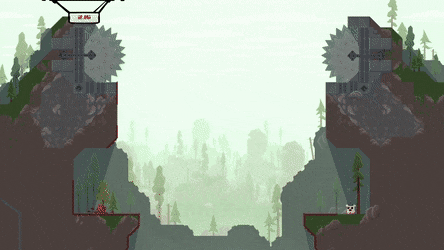
Nex Machina by Housemarque (the king of Gratification) – when the bullet hits an enemy, you get the confirmation of a successful hit via a subtle white flash over the enemy, who dies with a big explosion of cubes accompanied by relevant sound effects, giving you a sense of satisfaction and euphoria, by killing just one enemy. Imagine killing the boss. Different guns, enemies, levels, gratify the user at each point. I highly recommend playing this game!
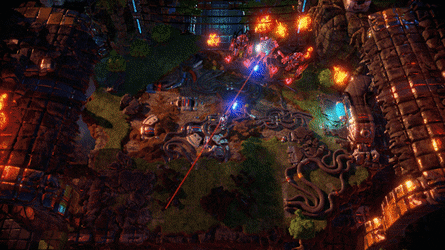
By this time, you might have realized that Gratification is such a broad topic that it probably needs a separate blog post. But, the reason I wanted to talk about it is to highlight how some of the best hyper-casuals understand Gratification well and use it to deliver a fun experience.
Remember Ball Blast? The ultra-responsive canon’s movement which accurately follows your finger, the hit feedback on bubbles and how they burst into smaller bubbles, the effect of temporary powerups on gameplay, and of course the ‘upgrades‘ – all these elements work together to deliver joyful feedback throughout the game.
Take any good game, and analyze the factors which gratify the actions making them enjoyable and you’d notice how these subtle details, often un-noticed, adds to the fun and immersiveness. Hyper-casuals are no different, and good designers take Gratification into account while crafting these systems. Another great example is Stack Fall (by Voodoo). You control a bouncing ball which falls when you tap and hold on the screen, breaking a stack of blocks along the way. Paint splatter, haptic feedback, destruction of blocks, are some of the elements that are really gratifying and enhance the experience.
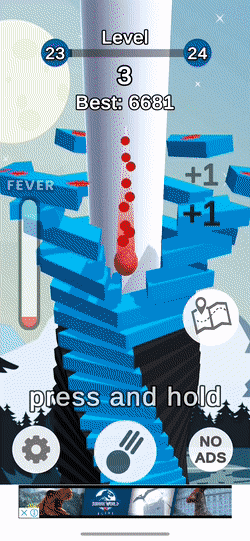
No matter what the action is, the player should feel satisfied doing it. Imaging a platformer game where the character jumps but when it lands, there’s no animation to convey the change of state or dust effects on the ground where he lands, imagine how odd and boring that’d feel. And it’s not just confined to game actions, you can also gratify the user through the UI by using relevant and subtle effects, and animations. One example I can think of is Homescapes. When you clear a level, multiple effects and animations play out to emphasise your victory and gratify your accomplishment. It’s even more rewarding when the level is hard, and you finally manage to clear it, the gratification received at the ‘Level Cleared’ screen makes it worth it. Not just the UI, but every action you make in a level is profoundly satisfying and a joy to watch.
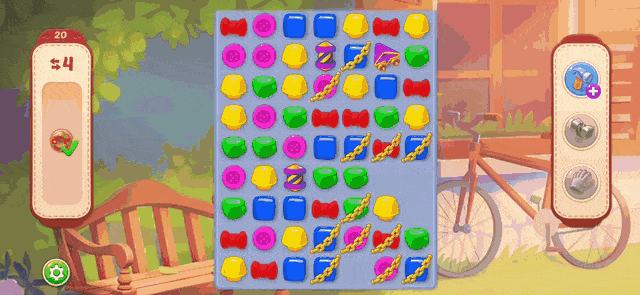
Now that’s what I call a HD quality GIF!
An engaging core loop combined with elements to enhance Gratification makes up the majority of the ingredients required to create a fun hyper-casual game.
To conclude…
I remember there was a time when I frowned upon hyper-casual games, but I had my reasons: non-existent art, little-to-none originality, aggressive use of ads, to name a few. I felt that innovative games were getting overshadowed by these swarm of hyper-casual games every week on the App Store.
I’m the guy who believes that games are a form of art, an experience crafted with polish and care, probably that’s why my games take years to come out of production. All these reasons combined didn’t create an excellent first impression of hyper-casual as a genre for me.
We, as designers, take pride in designing complex game systems, with multiple layers of depth but often neglect the simplest of things. Hyper-casuals have enabled me to pay attention to the finer details. It has allowed me to gain a new perspective while designing games. The core essence of a game which defines fun.
- A mechanic that’s hard to put down and doesn’t need any tutorial.
- Gratification to encourage the player’s actions and produce joy.
- Short feedback loops.
- Easy to get in and out.
- Sense of power/smartness in the form of progression.
- Simple meta to support the core gameplay
Who knows what the future holds for hyper-casuals. I don’t know if it’s here to stay, but there are several things to learn from the genre, which might be of help while designing your next game, be it of any genre.
I understand there are problems with the genre and the business model, but let’s leave that for some other day.
What do you think about hyper-casuals? Do you think it provides a fresh perspective in game design? Is there anything that you’ve learned from the genre?
---
Chirag is passionate about crafting experimental and narrative-focused interactive experiences a.k.a games.
As an Indie Game Developer, he operates under the label of Lucid Labs, where he has managed to create an Editors’ Choice game on the Apple App Store and was fortunate enough to be a part of Google’s first ever Indie Games Accelerator, and successfully graduate out of it. During his tenure as a Game Producer, he has shipped more than 15 games, in genres ranging from puzzle, RPG, match-3, social casino, arcade, and fantasy sports, satisfying more than 10 million users.
Chirag is currently working on Possessions with Noodlecake.
Twitter: @wearelucidlabs | @notthatchirag
Instagram/Facebook: @wearelucidlabs
Note: This article was originally published on Chirag's blog, and is republished here with kind permission.
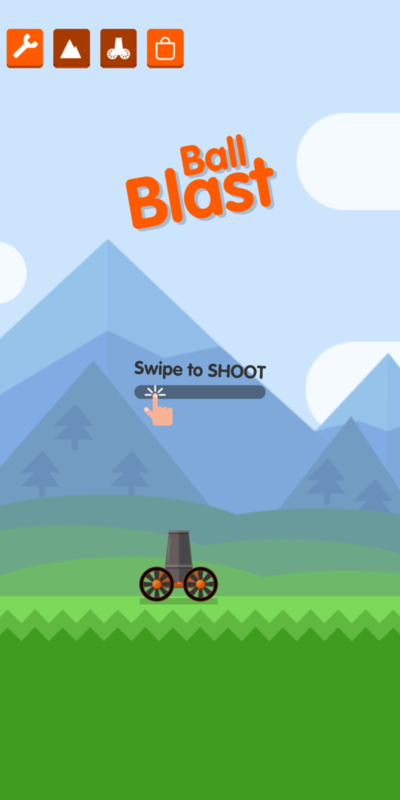


Good article, but I'm a hardcore player and I'm way past playing hyper-casual games. Thumbs up!
Thumbs up!